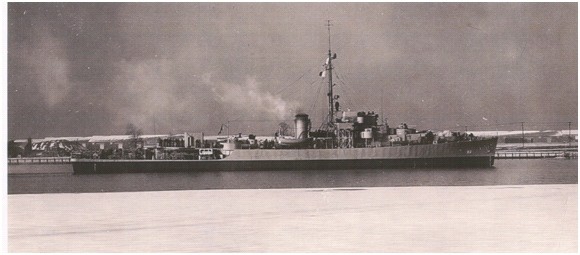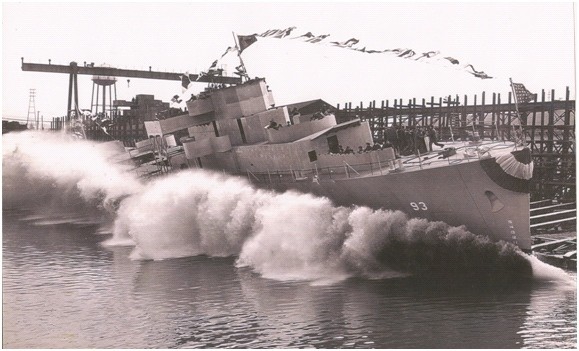

The frigate (PF-93) was named for the city in northern Ohio that had once been the home of then-Adm. Ernest J. King. The cancelled ships (APR-6 and APA-99), were to have been named for the county in Ohio.
__________
APR‑6 was assigned the name Lorain on 23 August 1942, but her contract was canceled on 12 March 1943, prior to the start of construction.
The unnamed district tug YT‑330 (q.v.) carried the name Lorain prior to her acquisition by the Navy on 19 October 1942.
APA‑99 was originally named Lorain but was renamed Dade ( q.v.) 19 November 1943 after being laid down on 2 September 1943.
Vallejo (PG-205), reclassified as PF‑97 on 15 April 1943, was renamed Lorain on 19 November 1943. Her contract was canceled on 11 January 1944, however, before she was laid down.
I
Roanoke (PF‑93) was laid down on 25 October 1943 at Lorain, Ohio, by American Shipbuilding Co., under a Maritime Commission contract (MC Hull No. 1965); was renamed Lorain on 7 February 1944; was launched on 18 March 1944; and sponsored by Mrs. Fred Henderson, a Lorain resident and mother of the late Maj. Lofton R. Henderson, USMC, who had been killed in action in the Battle of Midway. The hero's mother remarked during the ceremony: "I hope this ship will bring our boys back sooner. " Adm. King, present at the launching, added: "I say on behalf of the Navy, when [Lorain] comes in service she will be well manned, I hope, by many young men of this very community, and that when she meets the enemy she will be well fought. "Later, the Commander in Chief of the U.S. Fleet told a Lorain Chamber of Commerce assembly: "We still have a long way to go in this war. The seizure of the Marshalls, the bombardment of Truk and the Mariannas [sic] are but a sample to the Japanese of things to come. But let none of us forget this is an all-hands job."
Lorain ran her sea trials on 9 September 1944, and was placed in service on 13 October 1944, Lt. Comdr. Leslie B. Tollaksen in command, for ferrying to Curtis Bay, Baltimore, Md., where she was to be converted to a weather station vessel. Steaming via the Illinois Waterway and the Mississippi River, the ship arrived at New Orleans, La., on 28 September. Lorain sailed on the last leg of her delivery voyage on 16 October, and reached Curtis Bay on 25 October, where she was placed out of service on 31 October to be completed and outfitted. The final phase of her fitting out overseen by Lt. Harry E. Dennie, USCGR, Lorain was commissioned at Curtis Bay on 15 January 1945, Lt. Comdr. James G. Ramsey, Jr., USCGR, in command.
Lorain departed Baltimore on 28 January 1945, and proceeded via Norfolk, Va. (31 January-7 February), to Great Sound, Bermuda, arriving on 9 February, whence she conducted her shakedown. Completing that training on 27 February, Lorain sailed for Guantanamo Bay, Cuba, escorting the Italian submarine Tito Speri, arriving there on 3 March. Departing Cuban waters for Boston, Mass., on 5 March, the frigate suffered material damage during the test-firing of depth charges en route on 9 March, and reached her destination later that day. Following post-shakedown availability that lasted until 21 March, the ship sailed that day, only to return soon thereafter for an emergency availability that lengthened her time in the yard until 23 March. Departing the following day, Lorain patrolled Area M-2 en route to Casco Bay, Maine, arriving on the 25 th to conduct further training.
Following that period of work at Casco Bay, Lorain returned to Boston (9-11 April 1945), then sailed for Newfoundland with a convoy, reaching Argentia on 15 April. Remaining there until the 24th, the ship stood out on that day to commence her first stint of weather patrol work, on Station No. 3 (43-22'N, 39-44'W), punctuating that with a search for survivors on a raft (29-30 April) that ended with the word that the men had been picked up and to return to her station. Relieved by sister ship Greensboro (PF-101) on 13 May, Lorain returned to Argentia on 16 May.
Departing Argentia on 31 May 1945, Lorain patrolled Weather Station No. 5 (52-30'N, 30-00'W) between 2 and 23 June, visiting Reykjavik, Iceland, upon completion of that stint at sea (25 June-11 July). The ship operated on Weather Station No. 2 (60 °30'N, 33 °00'W) between 13 July and 2 August, after which time she returned to Argentia for voyage repairs and upkeep (7-19 August). Duty on Weather Station No. 4 followed (22 August-10 September), before she returned to Boston for an availability (15 September-20 October).
Standing out of Boston on 20 October 1945, Lorain patrolled Weather Station No. 9 (25 October-1 November), then returned to Boston on 6 November. Sailing again on 1 December, she visited Trinidad (7-10 December) before she set course for Recife, Brazil, in company with sister ship Shreveport (PF-23), reaching her destination eight days before Christmas of 1945.
Sailing on the last day of the year 1945, in company with Greensboro, Lorain then set a course for Trinidad. She ran aground on 4 January 1946, however, shortly before her arrival at her destination, but suffered no hull damage and carried out her port visit without further incident (5-12 January 1946), after which she sailed for Bermuda, arriving there on 16 January. She returned to Bermuda on 3 February following a stint on Weather Station No. 7 (20-30 January), and was to have sailed on 7 February until a generator casualty forced a delay. A period at sea on Weather Station No. 8 followed (10 February-4 March), after which Lorain proceeded to Boston, arriving on 7 March to begin an availability that would extend into the following month.
While Lorain had been at sea on Station No. 8, however, the Navy reached a decision (26-27 February 1946) to transfer her to the Coast Guard, directing (13 March) that she be decommissioned as a naval vessel prior to 15 March and then be recommissioned in the Coast Guard soon thereafter.
Subsequently, Lorain conducted one more weather patrol (on Station No. 6) (14 April-5 May 1946) before returning to Boston, arriving on 9 May.- Steaming thence to New York, where she remained until 15 August pending personnel replacements, Lorain, having been slated as early as 26 June to be disposed of in the 8th Naval District, proceeded thence to New Orleans. Arriving there on 6 September 1946, she was decommissioned the same day.
Nominated on 9 October 1946 for transfer to a foreign government for use as a weather patrol vessel and authorized for disposal on 19 November, Lorain departed New Orleans on 20 January 1947 in tow of the auxiliary tug ATA-211, arriving at Lake Charles, La., to be laid-up on 22 January. Removed from the reserve berthing area on 17 March, she was towed back to New Orleans by ATA-189, arriving on 19 March.
Sold on 26 March 1947 to the French Navy and commissioned on the same day as La Place (F.13), she was disarmed a year later, and served as a weather observation ship in the North Atlantic.
Ultimately, returning from a 21-day patrol off the coast of Spain, La Place anchored off St. Malo, France, where a mine, thought to be of World War II vintage, fouled the ship early in the mid watch on 16 September 1950. A contemporary Associated Press report stated that 42 people of the 93 known to have been on board had been recovered, but "hopes for the lives of the rest faded as night fell [on 16 September] on a coast churned by near-hurrican[e] winds. "
Robert J. Cressman
11 December 2012


